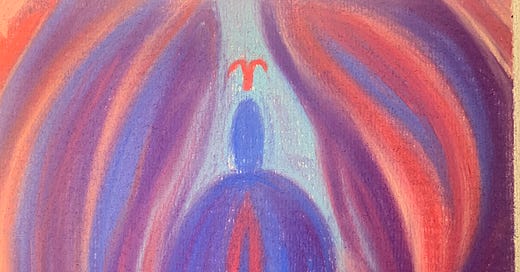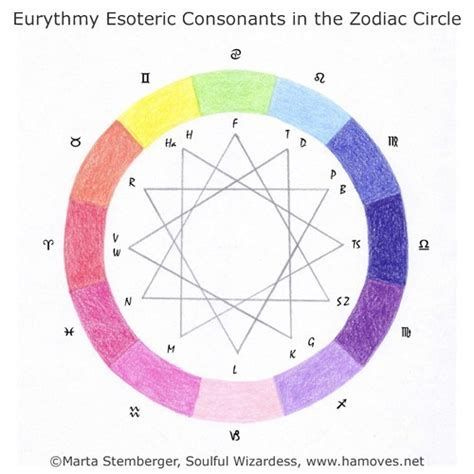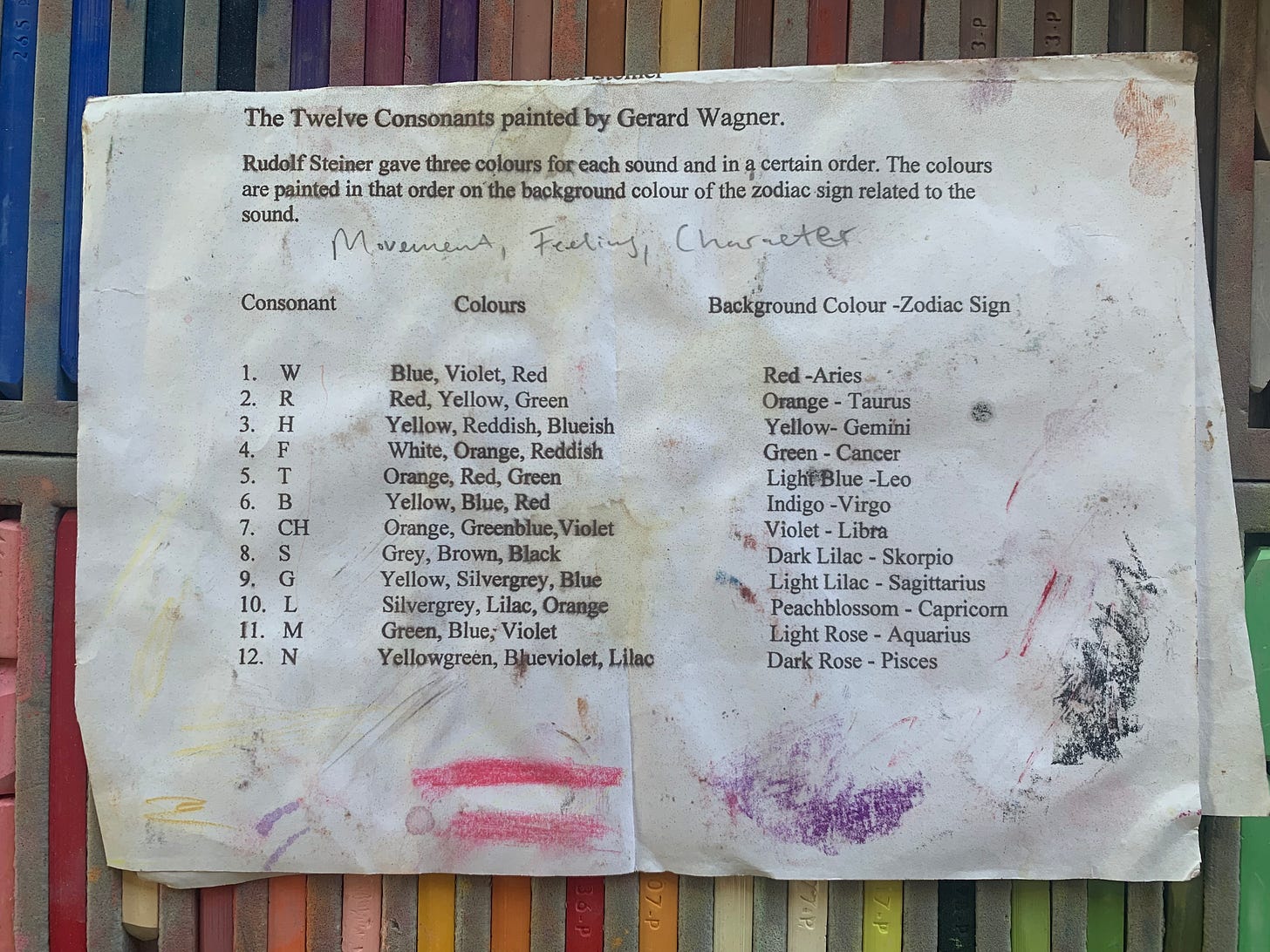Over the last year or so, I’ve been undertaking a project at the painting school I’m a part of here in Switzerland, focusing on the colors and Eurythmy gestures that Rudolf Steiner gave for each of the twelve signs of the zodiac. These have been a way for me to get deeper into a feeling for the spirit of the Zodiac, and it’s led to a lot of meditations on the nature of light and color as a part of our archetypal and spiritual experiences. I thought I’d share some of them here, as I prepare for my final presentation.
In a way, our relationship to light is the foundation of Astrology. Jyotish, Vedic Astrology, can be translated to ‘the Science of Light’. The formation of the zodiac can be connected to the waxing and waning of the ‘Luminaries’: the golden light of the Sun and the silvery light of the Moon. Astrology tracks both these changes in light and tries to capture the full spectrum of qualities to which pure, white light breaks down. Of course, this emerges out of and fades back into the darkness of night.
Color is also an easy inroad to a primal archetypal experience, a foundation of the doctrine of signatures upon which much esoterica rests. For example, there’s a quality of red that is nearly universal - an experience of energization, a primal part of the spectrum of human experience, evocative of anger, desire, self-protection, and assertion. We can see this in the hue of Mars, the red planet, whose meanings are often spoken of in relation to this red quality. A similar qualitative analysis can be seen in green, which relates to a more steady, simple liveliness - peaceful, harmonizing, supportive, and only threatening in its extreme expressions. Green is often given as a color associated with Venus, and we see another of her manifestations in the phrase, ‘green with envy’. These phrases about ‘the colors of the soul’ abound: someone is ‘feeling blue’, was ‘seeing red’, or has ‘dark eyes’.
This soulful potency of color is also emphasized in many spiritual and esoteric traditions. Priests and priestesses of many different traditions wear white in order to resonate with an ideal of purity. Other spiritual practitioners might wear black in a spirit of solemnity. The New Age musician, Laaraji, nearly only wears orange - which just simply feels right in his soul. We have the colors of the chakras, which are so intuitive and easily grasped. There’s an awareness of colors having a therapeutic quality, through color therapy, colorpuncture, and the power of interior design. Folks may want to know the colors of their aura or be able to see them as a part of psychic development, color revealing a deeper truth about the soul. Certain foundational exercises in developing the imagination in the Western Alchemical tradition involve concentration on different colored shapes, and, apparently, similar exercises were also an important but forgotten part of the early Buddhist canon. In astrological remediation, too, we work with different planetary and zodiacal colors as a type of healing and ritual art. In deeper forms of astrological magic, the mage works with different fixed stars and their associated gemstones, which radiantly reflect, capture, and transmit different colors.
By no means are these correlations always definite, simple, and true - there are so many shades of each color and so many contexts in which different qualities can arise. But I’d invite you to appreciate, for a moment, how special of a phenomenon color is. Color definitely exists externally - it is a common language, visible to nearly all, although some humans might be color blind and Mantis Shrimp might have 16 color receptors to our 3, unlocking realms of light and color we can’t even imagine. Still, we experience color in a profoundly qualitative, even internal manner. Quantifying color means almost nothing - speaking of them in terms of frequency and wavelength flattens the subjective experience so far as to eliminate it. It’s no wonder, then, that Goethe explicated through his Color Theory the foundations for a type of science based on phenomenology, which includes the participation of a thinking and feeling observer, recognizing that we can’t fully remove ourselves from relationship and that knowledge can be created from internal, subjective experience.
In the Anthroposophical world that I’m a part of, there’s a tradition of using watercolor painting as a form of therapy, which is actually practiced in Anthroposophical hospitals and medical settings as a part of a therapeutic regimen. It’s understood to especially work with our Astral Body - that realm of feeling, color, and light we encounter most profoundly through imagination, hypnagogic states, and dreaming. This is a realm of strong contrasts - sympathy and antipathy, desire and repulsion, levity and gravity.
I was first drawn to working with watercolor in 2017, after a bad breakup. Previously, music had been my main artistic outlet, but I found that I was just too sad to play guitar or sing - I had been dumped by a musician, and most of the songs I knew by heart were sad songs. Playing with watercolors was an opportunity for me to feel in a spacious manner, with no direction and no need to make sense. Everything could be entirely abstract, floating, congealing and dispersing. I saw this healing nature outwardly while I was working at a Waldorf School that same year - we had a terrible, unspeakable tragedy unfold in one of the classes I was helping, and the school brought in a painting therapist to provide a space for the kids to process the trauma. I got to do a session one day and felt that I came to an important insight about myself, which felt like it was heard and appreciated by the spiritual world.
This encounter with color bled into my inner world in other ways quite profoundly. I found that, after spending a while playing with liquid color, those colors would continue to play through my mind’s eye, as if the colors themselves were living spirits, working their way through me. During my first summer in Switzerland, I got to participate in a week-long course at the school I’ve been a part of for the last two and a half years, in which we worked with plant-based color pigments and very simple exercises - starting with yellow at the center and blue at the periphery and allowing the painting to grow proportionally. After the week, I felt my eyes had been somehow tuned to finer qualities of color. The only thing I could compare it to was my experience of perception while on LSD - suddenly everything was more vibrant, with more of the spectrum of color announcing itself to me. Amidst summer in Switzerland, with hour-long sunsets and plants in full bloom, I felt I was in paradise.
The training of the school, which I undertook for 15-20 hours a week for a year and a half, is conceptualized as more of a science than an art, directing itself towards developing soul capacities for the feeling of different colors and their appropriate proportion. We would go systematically through different sequences of color and the nine different ‘nature moods’ that Steiner gave to painters, especially for adolescents to practice in order to feel into archetypal nature processes, like sunrise and sunset and moonrise and moonset. The progenitor of this school, Gerald Wagner, really thought of this activity as spiritual science, encountering the being of color and discovering how color created form. His work is incredibly rich and well-loved, even as it comes out sometimes looking quite childish or simplistic.
For the last year, I’ve been working on an independent project, studying the colors that Steiner gave for each of the signs of the Zodiac, especially in the context of Eurythmy - a movement art that seeks to create ‘visible speech’, expressing the quality of different sounds. Many of these sounds are connected to Zodiacal energies, the idea being that these are the essential formative forces of the universe. ‘In the beginning was the Word’ - this is not just an idea, but actual sound - vibrating life. This life is light, which broke itself into the whole spectrum of color. In Eurythmy, these colors also have movements, and Eurythmists will wear gowns and veils of different colors in order to express and play with these archetypal spirits.
The chart above is a depiction of how Steiner understood these sounds and colors to weave together with the Zodiac. Each of these sounds has their own gesture/movement, which are often used in therapeutic contexts, as well as in performative, artistic Eurythmy. I once asked Therapeutic Eurythmist if he ever used the astrology chart to diagnose what a patient might need - he said no, that he could diagnose it without, and told me that I would benefit from practicing the sounds of ‘B’ and ‘F’, which, as you can see here, are associated with Virgo and Cancer (my Jupiter and Ascendant placements). Each sign also has their own Eurythmy gesture, which is what I’ve focused on, although I’ve certainly a long way to go in order to really capture and integrate all of these moving pieces.
In a visual arts context, these colors are actually the backgrounds for a further sequence of colors, which you can see below. My practice in working with these colors has actually been lightly inspired by the approach to creating talismans in a traditional astrological ritual context. I’ve followed the Moon, allowing her to receive the impressions from each sign of the Zodiac, and focused my attention alongside her movements. Each time, I feel like I’ve gotten a stronger understanding of the nature of each of the signs - as if it’s a whole mood, a whole world of color to explore. In turn, this has reshaped my understanding of what ritual might look like, and what its functions might be. Working with these colors can very much be an invocation of a particular quality of experience, which then gives me a more complex and deep appreciation for that slice of life. In a way, it’s about building a relationship in the development of intuitive knowledge - exploring a space, playing, and gaining familiarity for different qualities as a path to healing, greater liveliness and developing skillfulness.
By contrast, a lot of what I experience in the astrological magic space feels comparatively stuffy and rigid. A lot of old traditions of astrological ritual have to do with working with different images and symbols in a manner that often makes one keenly aware of the cultural context they came out of. As the Golden Dawn saying goes, “By names and images are all powers awakened and reawakened.” The images depicted in books like the Picatrix are certainly profound and stirring, but they are also starkly gothic - it takes gumption to even start engaging with them. I appreciate anthroposophy’s articulation that, to a certain degree, our inner self is somewhat of a child and needs imaginative food that feels safe, easily accessible, and softly nourishing. I think there’s also an inner teenager that needs edge and thrill, but that’s not the baseline for me. In this regard, I prefer the second important saying from the Golden Dawn: “Colours are not symbols of forces, but the forces themselves.” I’m by no means an initiate of that system, but the approach of Steiner seems like an elegant and thorough extension of that principle.
The process I’ve started to undertake is certainly incomplete, and I certainly don’t take Steiner’s approach to be the complete, infallible picture. This is just one astrological cosmology amidst a vast multiplicity of astrologies, but a certainly rich and nuanced one. A guiding principle for me over the past few years has been to emphasize my role as an artist in my astrological practice, rather than focusing on the rigid systems of prediction and delineation that is in vogue with many of my peers. This artistic element of astrology is easily accessible - it is found in the simplicity of star poetry, in which the language of astrology provides a platform for connection and transformation, with oneself, with other people, and with the cosmos. Although the poetic language of astrology, its archetypal ideas, the terms and stories associated with the planets, signs, and houses are the elemental tools of my practice, exploring these colors has expanded my palate, so to say.
It also seems to me that the importance of color can provide a foundation for further exploration of astrology as a sort of spiritual science. Over the past three years or so, I’ve been lucky enough to receive regular reports from Olivia Pepper about their dream-time encounters with different stars - Olivia comes back with different rich color schemes, with beautiful, precise names for different colors. This is not based in tradition, in some abstract authority, nor is it meant to be the final word. In this light, we can see astrology not as something that was set in stone by sages of some ancient era that must be rediscovered, but something that can emerge through the bright mights capable of interacting with the astral light.
Aldebaran: Periwinkle, lilac, light pink, radiant light and the most ecstatic spring green, yellow - the most incomparable yellow. Yellows, violets, whites, pinks. Play, sensuality, divine ritual union, fertility, fecundity, possibility, alchemical union points. Joyous and mischievous
Sirius: White and yellow and gold, marigold, apple green, sage green. Chartreuse, lemony feeling. Like being in a blooming orchard.
Regulus: Somber.. a king star.. A deep brown, eggplant, Burgundy. Red, bright red, blood red, a brick red, a terra cotta color. A muted orange. Lots of brown and red, a feeling like an antiquated luxury, a decaying grandeur.
Olivia’s encounter with the stars bear a similarity to certain work done by Hilma af Klint during her time here in Dornach, where she undertook systemic observation and meditation upon different plants. Following what seems to be Rudolf Steiner’s instructions in How to Know Higher Worlds, Hilma documented what she experienced as a sort of being or spirit of different plants, encapsulating these qualities in different seal-like images and giving a few words describing her feeling for the nature of the plant, what she called ‘Richtlinien’, or ‘Guidelines’. In Flowers, Lichens, and Mosses, af Klint recorded the results of this research. Here are a few samples:
Pyrus communis (European or common pear): “Give me enlightenment about my astral weakness. Help me to improve the kidneys of humanity.”
Prunus spinosa (blackthorn): “The incorruptibility of the law. The inexhaustibility of the gospel.”
Prunus cerasus (sour cherry): “Liberator of the intestinal bacteria and infusiora that are caused by animal foodstuffs.” (af Klint was a vegetarian.)
As Ezra Pound said, ‘artists are the antennae of the race’. Who are we to doubt that these capacities for subtle perception can result in genuine knowledge, or to limit the extent of that knowledge? And why can’t we see this as a form of magic, or the essence of magic, always renewing - not making things happen through coercion of non-human beings, but of developing relationships with them, learning about them and translating them into other forms and languages? Color is one of these foundational languages, and it seems a rich medium for soul-spiritual exploration.
If this article sparked any interesting thoughts, please send them my way! I’d love to be directed to other phenomena in this field, if anyone knows of any <3
Likewise, if you appreciated this post, please consider becoming a paid subscriber - it encourages and supports this fledgling, ambitious, and yet-to-be-proven project.
Finally - if you appreciated the comments about Hilma af Klint, you might check out an interview I recently did on her work and relationship to Steiner and anthroposophy:
We also published this accompanying article about her ‘Esoteric Botany’.








